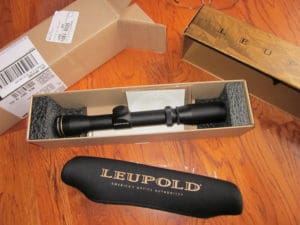 There aren’t many gunmakers left in Oregon these days. Kimber used to be located here; a corner of the country where law-abiding adults can buy a firearm with relative ease. The company upped stakes and moved to Yonkers, New York, where they can’t. Fortunately, the Beaver State is still home to products near and dear to shooters’ hearts, such as Uncle Mike’s and WD-40. Leatherman is here, still manufacturing as the Universal Bubba Gunsmith tool for people who don’t mind chewed-up screw heads. The jewel in this crown of domestic gun-stuff manufacturing: Leupold, a if not the premier American manufacturer rifle scopes and hunting optics. Because of my parsimonious nature (show me a gun over $350 and I’ll show you a gun I don’t own), I’ve never owned a Leupold scope. That’s going to have to change . . .
There aren’t many gunmakers left in Oregon these days. Kimber used to be located here; a corner of the country where law-abiding adults can buy a firearm with relative ease. The company upped stakes and moved to Yonkers, New York, where they can’t. Fortunately, the Beaver State is still home to products near and dear to shooters’ hearts, such as Uncle Mike’s and WD-40. Leatherman is here, still manufacturing as the Universal Bubba Gunsmith tool for people who don’t mind chewed-up screw heads. The jewel in this crown of domestic gun-stuff manufacturing: Leupold, a if not the premier American manufacturer rifle scopes and hunting optics. Because of my parsimonious nature (show me a gun over $350 and I’ll show you a gun I don’t own), I’ve never owned a Leupold scope. That’s going to have to change . . .
Thanks to TTAG’s ever-growing readership (that’s you!), Leupold agreed to lend us a VX II Variable 1.5-4x28mm Scout Scope for my scrutiny and your consideration. As the name implies, it’s an intermediate eye relief rifle scope. It’s designed to be mounted forward of a rifle’s receiver and used with both eyes open at low power. In this scope’s case, at medium power too.
Disclaimer: scout scopes aren’t for everyone. They’re not for every rifle. But shooting with both eyes open is, generally speaking, a good thing. In a self-defense scenario, the advantages are obvious; you can’t have too much situational awareness. The Leupold VX II Variable Scout Scope is not a tactical optic per se. For close-in work, it can’t hold a candle to a proper red dot. But scout scopes work well enough with many tactical carbines, and enable a dual-purpose firearm.
Remember this video from the National Shooting Sports Foundation’s attempt to rebrand assault rifles as “modern sporting rifles”? Like that. For hunters, a two-eyes-open optic helps them assess what’s going on around their prey. With a more complete sense of the total environment, a hunter can better anticipate their target’s behavior. Or switch to an alternative animal.
Scout scopes can also be good general purpose short/medium range optic for shooters whose eyes just no longer work well with iron sights. And last but not least, many lever actions and military bolt-actions have no way to mount a conventional scope low over the receiver, leaving a scout scope as the optimum optical option.
But back to my point, and yes I have one. The Big Brown truck dropped off my (note “my”) VX II Variable 1.5-4x28mm Scout Scope last night. Until I get a break from defending alleged criminals from the long arm of the law to mount this scope and shoot with it, here are my first impressions:
Everything on the VX II is slick, solid, and tight. There’s no tick or rattle of unsecured lenses, no bright or dull spots in the uniform matte finish, no scratches and no smudges on the glass. Yet. The dials and screws all turn with firm precision; not too easy and not too hard.
The VX II Scout Scope ships with product documentation that reaches a Philip Glass-ian level of minimalism. You get a scope, a well-made neoprene scope cover (no lens covers), a bumper sticker, a product registration/warranty card and an installation and adjustment guide printed in English, French, Italian, German, Croat, Khoisan, Ogham and Rongaronga. Okay, I exaggerate. But for a piece of four Benjamins and up piece of kit, I expected a little more swag and a lot more information. In English.
In the end it’s the scope itself that will justify its price or not, so let’s move on . . .
At 8.8 ounces and a full 11″ long, this is not a ‘compact’ or ‘featherweight’ scope. Other high-end scout scopes are two inches shorter and two ounces lighter. That said, the VX II variable is essentially the same size and weight as a conventional 28mm scope. While it;s not a lead brick (it’s more than two ounces lighter than the smallest Eotech), it might be out of place on an exceptionally compact and lightweight scout rifle.
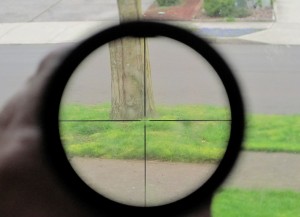 One benefit of this added size: the larger VXII can dial down to really low power for those shooting situations where you don’t want or need to zoom in. The above photo shows how it looks at the lowest power setting (1.75x actual magnification). What the image cannot convey: the huge size of the ‘sweet spot’ where you can position your eye to fill the scope properly. At low power, it’s simply huge.
One benefit of this added size: the larger VXII can dial down to really low power for those shooting situations where you don’t want or need to zoom in. The above photo shows how it looks at the lowest power setting (1.75x actual magnification). What the image cannot convey: the huge size of the ‘sweet spot’ where you can position your eye to fill the scope properly. At low power, it’s simply huge.
Magnification is adjusted by a short turn of the dial in the picture above: the adjustment is smooth and firm, and it twists from 1.5x to 4x in slightly more than 90 degrees. This rocks. Cheaper scopes (of mine) require 180 degrees or even 270 degrees of twist to adjust from 3x to 9x. That much twisting requires two or three separate hand movements; it gives that elk or whitetail plenty of time to wander out of your field of fire, mate, and die of old age.
If you don’t mind the weight and size, the Scout Scope’s light-gathering ability is another major plus. The smallest scout scopes feature a 20mm objective lens. Leupold’s 28mm objective can gather nearly double the photons as those smaller scopes. This translates into much brighter images at all magnifications (becoming more significant at higher power) and much better shooting near dawn and dusk or in overcast weather.
At 7:00 p.m. on a heavily overcast spring evening, the VX II dramatically brightened-up the dark shadows under the cedar forest in my shooting buddy’s backyard. With the naked eye, a hypothetical hunting shot under those weather and lighting conditions would have been unethical at best, criminally reckless at worst. With the light-gathering ability of this scope it would have been perfectly safe, legal, and ethical.
[NOTE: Don’t freak out at the thought of your correspondent sighting down a rifle at his friends and neighbors; the scope rested on anything more dangerous than a sofa cushion while I scoped out my buddy’s backyard.]
As indicated above, my sample came with no helpful hints on eye relief, exit pupil, or parallax settings. I’ve got some research ahead of me. My brief experiments last night showed no visually perceptible shift in the aiming point between approximately 10 yards and 75 yards, while I bobbed and weaved my eye around in the sweet spot of the perfectly stationary scope. Inside of 10 yards the parallax was pronounced—which is completely irrelevant unless you plan to shoot your scout rifle inside your living room.
I couldn’t check for parallax beyond 75 yards because of the sight-lines available from my dining room. Leupold doesn’t specify the parallax setting for this scope (published data is still skimpy on this brand-new product), but other Leupold IER and LER scopes are set to be parallax-free at 50, 75 or 100 yards.
A word about Optics:
Speaking of parallax, why is it that all scopes seem to do about the same things in terms of magnification, field of view, parallax, etc, even though some scopes do the same things better? Why can’t somebody invent a subcompact variable 1x to 20x riflescope with unlimited eye relief, zero parallax at any distance, a 100 foot field of view at 100 yards, and a huge sweet spot? The one-word answer: “physics.”
In any environmental situation, there are only so many photons to go around, and there are only so many ways you can bounce them around, spread them out or gather them together.
In this universe, Leupold and Barska are subject to the same laws of optics that Christiaan Huygens and Isaac Newton discovered in the 17th Century. Without getting too technical, let’s just say that all telescopes operate within absolute physical constraints imposed by their physical dimensions. In optics, everything you want comes at the expense of something else. Magnification is gained at the expense of brightness, FOV, and exit pupil. Brightness and FOV come at the expense of magnification and eye relief.
The only sure way to get ‘more’ of any attribute (power, brightness, FOV, etc) without sacrificing another attribute: make the scope itself larger. Obviously, there’s a limit to how large a rifle scope can be.
With the right eyepiece, my Celestron 5″ Schmitt-Cassegrain has a gargantuan 30mm exit pupil, a huge field of view, and 30x magnification. It gathers so much light it can turn night into day. The optics are so precise that they constitute less than one wavefront of optical error. It would be a great rifle scope if it wasn’t bigger than a coffee can and weighs ten pounds. Oh, and the recoil of a single .223 shot would damage it beyond repair.
And Now Back To The Review:
Scout scopes sacrifice optical power (magnification and FOV) in order to gain a larger sweet spot (eye relief and exit pupil) within a relatively compact form factor. The Leupold VXII scout scope has about twice the eye relief and exit pupil of a conventional Leupold scope, but gives you only about half of the available magnification and half of the FOV at any given distance and magnification. These are not indictments of this scope, but a consequence of the laws of physics. If your needs dictate higher magnification and a wider field of view at the same time, scout scopes are not for you.
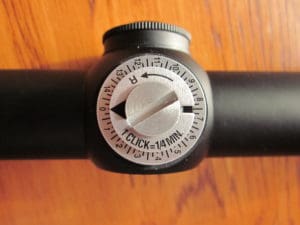 The Leupold’s zero is adjusted by means of slotted elevation and windage adjustment screws, both protected by waterproof caps. The whole scope is guaranteed waterproof, so I guess the caps make it double-waterproof; they mostly serve to prevent inadvertent zero adjustments.
The Leupold’s zero is adjusted by means of slotted elevation and windage adjustment screws, both protected by waterproof caps. The whole scope is guaranteed waterproof, so I guess the caps make it double-waterproof; they mostly serve to prevent inadvertent zero adjustments.
I love that the screw slots (pictured above) are wide enough to twist comfortably using two fingernails, instead of ripping and twisting my thumbnail. Traditionalists can also use a coin or (gasp!) an actual screwdriver.
Once the rifle is zeroed, you’ll be able to use that same undamaged thumbnail to gently but securely twist the pointer dial back to the “0” marker so you can return your rifle to a standard zero after making any needed field adjustments. I wouldn’t use the screwdriver for this; it would probably scratch the index dial.
I should point out that, since this scope is only sold through the Leupold Custom Shop, you’ll be able to order it with virtually any type of zero adjustment dials you like, at extra cost. You can also select from several available reticules and finishes, and add a bullet drop compensator dial specific to your favorite handload, funds permitting.
As with any decent scope, the eyepiece is adjustable for focus.
Check back in the next month or two as I strap this scope to a mild-kicking .357 Magnum carbine, a long-barreled rifle, and finally a short-barreled carbine in the full-powered 7.62x54R cartridge. The recoil and infamous concussion of the M44 Mosin-Nagant carbine can brutalize lower-quality scopes and leave them bleeding from every orifice, so it should prove to be a rigorous test platform for this hopefully stout scout scope. We’ll also test the waterproofing and (rifle accuracy permitting) measure the precision and repeatability of the zero adjustments.
Watch this space.


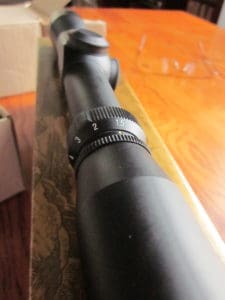
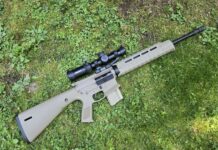
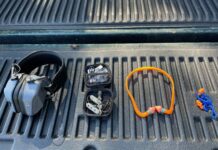

“Why can’t somebody invent a subcompact variable 1x to 20x riflescope with unlimited eye relief, zero parallax at any distance, a 100 foot field of view at 100 yards, and a huge sweet spot? ”
That could actually be done by going digital. Swap all those precision-ground lenses for a small digital camera, tiny computer to process the images, and a little lcd screen and you can trade all those concerns for worrying about your battery. Probably wouldn’t be too expensive, but battery concerns would kill it’s popularity, which is probably why no one is making one.
Now that’s a pretty damn good idea. I have a little aux LCD viewfinder on a digital camera of mine that augments the big screen on the back. It’s not a stretch to imagine a scope based on that concept.
You should design one. If you do, then go talk to this guy.
The resolution of the best digital imaging sensor available today is still lower than that of a cheap scope.
More importantly, the contrast range is very narrow and has a higher threshold for minimum illumination.
I’m drooling already Chris. Scout set ups are my hidden obsession and I’ve always wondered about those Leupolds that were far beyond my means. I can’t wait to see how it performs.
The VX II Scout Scope ships with product documentation that reaches a Philip Glass-ian level of minimalism.
I got a Kahles Multi-Zero a while back and what little information there was looked like it had been run through google’s german to english translator.
My Leupold Prismatic came with plenty of documentation.
This new Leupold Variable power Scout Scope has another advantage not mentioned: An adjustable focus ring for those needing diopter adjustment for clear focus. The fixed power Leupold Scout models do not have this feature.
Bringing variable power to the Scout Scope concept should convince manufacturers of fully rifled slug barrels to bring back the handy low barrel mount feature for interchangable barrels. The low mounting qualities of the Scout Scope eliminate the need to add high comb inserts to effectively use the slug barrel option.
Perhaps Big Green/New England Arms will also see the value a forward mounted Scout Scope can bring to the NEF single shot rifle line. Introducing a properly designed forward mount would give NEF fans the option of mounting a Scout Scope with the rear lens even with the breach of the barrel – eliminating the need for extra high mounts to clear the high hammer on these models.
People go where the roads go – so mount designers and industry marketing departments need to get off their duffs and lay some “pavement!”
Leupold, Burris and Weaver, are you listening?
I wanted to install a scout scope on my Mosin Nagant 91/30 since my old eyes don’t seem to like iron sights these days. Alas, the rear sight on my Nagant, which must be removed to mount the scope base, is welded instead of being screwed, so I’m screwed too. So, when you try the Leupold on the M44 Carbine, please don’t rave too much. That would break my heart.
Ralph,
The S&K mount is one of the few Mosin-Nagant no-gunsmith mounts that attaches solidly and holds its zero. It’s not as low over the bore as other mounts which attach directly to the barrel, but it might work for your M44. It’s not cheap; it costs almost as much as the rifle.
The S&K mount replaces the rear sight, which is held on by a screw on most Nagant rifles and carbines. But my Nagant’s rear sight is welded on and can’t be removed, thus my 91/30 is destined to remain without optics. Sigh.
So is your shooting review of the scope going to be coming out now that you have hour lever gun issues worked out? Dying to hear what you think about it. Mine is inbound from Leupold as I type this.
I’m fixing to do a shooting comparison of my Leupold VXII 1.5-4x 28mm with the Burris 2.75x 20mm Scout and the Weaver Classic K 4x 28mm Scout. These 3 scopes being the only ones that I am aware of that have a focus-able eyepiece that is so important to blind old guys…
I have and love the traditional FXII 2.5x 28mm Scout from Leupold – I just can’t see the bloody reticule because I’m a blind old guy. Anyway – I’d love to hear your review if you get around to it…
Very interested in your review and comparison of the scout scopes…
Rod B
rodbrink@yahoo.com
So is your shooting review of the scope going to be coming out now that you have hour lever gun issues worked out? Dying to hear what you think about it. Mine is inbound from Leupold as I type this.
I’m fixing to do a shooting comparison of my Leupold VXII 1.5-4x 28mm with the Burris 2.75x 20mm Scout and the Weaver Classic K 4x 28mm Scout. These 3 scopes being the only ones that I am aware of that have a focus-able eyepiece that is so important to blind old guys…
I have and love the traditional FXII 2.5x 28mm Scout from Leupold – I just can’t see the bloody reticule because I’m a blind old guy. Anyway – I’d love to hear your review if you get around to it…
You should also include the Nikon 2.5-8 ler scope in your tests. It has an eye relief of 12 inches at the low power setting (up to 4 power). From 4 to 8 power the eye relief is at 9 inches. I have found the performance of this scope to be outstanding on my Swedish Mausers. I use the lower powers for offhand standing and sitting. For long range prone, I move the power up to 8. The prone position pushes your eye closer to the scope, and the decreased eye relief is perfect. Not to mention the increased power provides better resolution at long ranges.
Our Company is involved with proprietary, no drill Mauser Scout systems, for the 98 and the Swedes (sorry we don’t do the Mosins). I am very interested in your evaluation of this new scope offering by Leupold. I too rejected their original 2.5 scope, because of the lack of adjustable diopter correction. I have found the Burris to be excellent, and am in the process now of evaluating the Weaver.
Besides proper eye relief, The range of internal adjustment is also critical to a scope evaluation. The Burris offers 140 inches, The Weaver 50, and the Nikon only 40. Anyone interested in possible long range applications, such as silhouette, or 600 yd , needs as much internal correction as possible. This information on the new Leupold offering, would be apprectiated.
I have the Leupold Scout Scope on a Steyr Scout Rifle and it is excellent for what it is intended. Fast work out to about 200 yds. I tested it against EOTech 512, Bushnell and a Nikon EER pistol scope. The dot sights work great at 50 yds. and less. Very fast. The Nikon does not work for quick shooting as obtaining and maintaining the proper head position to see the target is too difficult. The Leupold is great. Most of my shooting is on hogs and coyotes. I hit the hogs anywhere from 25 yds. to 50 yds. and the shoot running targets from 10 yds. to 100 or so. I have dispatched a few stationary coyotes between 250 and 300 yds. Over that they get really small. The Leupold works for all of that. However, my old eyes need a little magnification past 200 yds. and I’m sure the focus issue is coming. I’m hoping the variable power scout scope will solve the proplem. The Nikon worked well on the bench but in the field I spent too much time searching for the sight picture to get good shots after the first one.
Do I contact the Custom Shop directly to order this scope? What do I ask for?
more info available as yet?
My new Leupold scout is sitting next the GSR waiting for shipping instruction back to Leupold for repair. No shots fired. First attempt to remove wind age dust cover resulted in entire assembly exiting the tube. So much for water tight integrity and quality control. Put an interim Nikon p-223 4x on which seems fine. The GSR has the xs rail with rear aperture; seems like a good way to expand mount options. Also have a Leupold VRX 1.25-4 which seems a good match for the GSR.
I am unenthused about yet more delay to get the scout scope sorted out and will provide follow up on Leupold response; got to expect a lemon once in a while, if they get it right in a reasonable time I will be pleased.
Comments are closed.